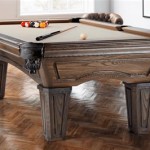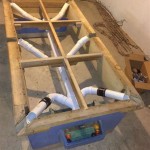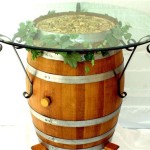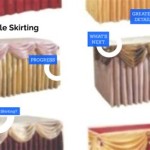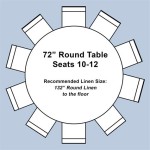Painted Singer Sewing Machine Tables: History, Restoration, and Decorating Ideas
Singer sewing machine tables, particularly those with cast iron bases, represent a unique intersection of industrial history, functional design, and decorative potential. Originally designed as working surfaces for Singer sewing machines, these tables have transcended their initial purpose and are now frequently repurposed as accent furniture, offering a blend of vintage charm and practical utility. One popular method of transforming these tables is through painting, which allows for customization and integration into diverse interior design schemes. The appeal of painted Singer sewing machine tables stems from their robust construction, distinctive aesthetic, and the possibility of personalized expression through color and artistic techniques.
The Singer Sewing Machine Company, founded in 1851, revolutionized the textile industry with its innovative sewing machines. Accompanying these machines were purpose-built tables, typically featuring a heavy cast iron base and a wooden top. The cast iron bases were designed for stability and durability, often adorned with intricate scrollwork and the Singer logo. The wooden tops provided a flat surface for sewing and could be folded down when the machine was not in use. Over time, as sewing machines were replaced or upgraded, these tables often remained, becoming relics of a bygone era. Their inherent sturdiness and the growing interest in vintage and repurposed furniture have fueled their resurgence as decorative items.
The process of painting a Singer sewing machine table involves several key steps, starting with thorough cleaning and preparation. The cast iron base, often covered in rust and old paint, requires meticulous cleaning using wire brushes, sandpaper, or even chemical rust removers. The goal is to remove loose paint, rust, and other debris to create a smooth and receptive surface for the new paint. The wooden top also needs preparation, involving sanding to remove old varnish or paint and to smooth out imperfections. Depending on the desired finish, fillers can be used to repair cracks or dents in the wood.
Once the surfaces are clean and prepared, priming is essential. A primer provides a uniform base for the paint to adhere to, improving its durability and preventing the underlying material from affecting the final color. For cast iron, a rust-inhibiting primer is recommended to prevent future corrosion. For wood, a wood primer is suitable to seal the surface and ensure proper paint adhesion. The choice of paint is also crucial. Oil-based paints offer durability and a traditional finish, while latex paints are easier to work with and clean up. Acrylic paints are another option, providing good color retention and water resistance. The selection depends on the desired aesthetic, the intended use of the table, and personal preferences.
The application of the paint can be done using brushes, rollers, or spray paint. Brushes offer precision and control, allowing for detailed work on the intricate cast iron designs. Rollers are suitable for larger, flat surfaces like the wooden top. Spray paint provides a smooth, even finish, particularly on the cast iron base. Multiple coats of paint are often necessary to achieve full coverage and a durable finish. After painting, a clear coat of sealant can be applied to protect the paint from scratches and wear. This is particularly important for tables that will be used frequently or exposed to moisture.
The Allure of Painted Cast Iron Bases
The distinctive cast iron base of a Singer sewing machine table is a major factor in its decorative appeal. The intricate details, such as scrollwork, floral motifs, and the Singer logo, provide a rich visual texture that can be enhanced through painting. Different painting techniques can be used to highlight these details. For example, dry brushing involves applying a small amount of paint to a brush and then wiping off most of the paint before applying it to the surface. This technique leaves paint in the crevices and raised areas, accentuating the design. Another technique is antiquing, which involves applying a darker glaze or stain over the painted surface and then wiping it off, leaving the darker color in the recessed areas. This creates a vintage, weathered look that complements the table's history.
The color choice for the cast iron base can dramatically alter the table's overall aesthetic. A classic black or dark grey finish provides a timeless and elegant look, while a bright, bold color can create a statement piece. Metallic paints, such as gold, silver, or copper, can add a touch of glamour and sophistication. The key is to choose a color that complements the surrounding decor and reflects the desired style. Furthermore, the base itself can be disassembled for easier painting and cleaning, and then reassembled once the paint has dried. This ensures that all surfaces are adequately covered and that the paint adheres properly.
Beyond solid colors, experimentation with different painting techniques can yield unique and eye-catching results. Stenciling, for instance, allows for the addition of decorative patterns or motifs to the cast iron base. Crackle painting creates a textured, aged appearance, while ombre painting involves blending different shades of the same color to create a gradient effect. The possibilities are limited only by imagination and creativity. However, it is important to consider the overall style of the table and the surrounding decor when choosing a painting technique. A heavily embellished base may clash with a minimalist interior, while a simple, understated base may be ideal for a more eclectic setting.
Revitalizing Wooden Table Tops
The wooden top of a Singer sewing machine table offers another opportunity for decorative expression. Depending on its condition, the wooden top may require significant restoration before painting. This could involve sanding to remove old varnish or paint, repairing cracks or dents, and applying a wood filler to create a smooth, even surface. The type of wood used for the tabletop can also influence the choice of paint and finishing techniques. Hardwoods, such as oak or maple, are durable and can withstand heavier use, while softwoods, such as pine, may require more careful handling.
When painting the wooden top, it is important to consider the desired finish. A solid color can provide a clean and modern look, while a stained finish can highlight the natural grain of the wood. A distressed finish, achieved through sanding or other techniques, can create a vintage, rustic appearance. The choice depends on the overall style of the table and the surrounding decor. For example, a white-painted top with a slightly distressed finish can complement a farmhouse-style interior, while a dark-stained top can add a touch of elegance to a more formal setting.
Beyond solid colors and stains, there are numerous other painting techniques that can be used to enhance the wooden top. Decoupage involves adhering paper cutouts or fabric to the surface and then sealing them with varnish. This can be used to create a unique and personalized design. Stenciling can also be used to add decorative patterns or motifs to the wooden top. Faux painting techniques, such as marbling or wood graining, can create the illusion of different materials. The key is to choose a technique that complements the overall style of the table and reflects the desired aesthetic. Additionally, a protective sealant is crucial to safeguard the painted or stained wooden top from scratches, spills, and general wear and tear. Polyurethane or varnish provide durable, water-resistant finishes that extend the life of the tabletop.
Creative Repurposing and Decorating Ideas
Once painted, a Singer sewing machine table can be repurposed in a variety of ways. It can serve as a side table in a living room or bedroom, providing a surface for lamps, books, and other decorative items. It can be used as a plant stand, showcasing potted plants and adding a touch of greenery to a room. It can also be used as a small desk or workstation, providing a compact and stylish space for writing or using a laptop. The versatility of the table makes it a valuable addition to any home.
In a living room, a painted Singer sewing machine table can be placed next to a sofa or armchair, serving as a convenient surface for drinks, snacks, or remote controls. The table's unique design can add a touch of character to the room, especially when paired with other vintage or eclectic pieces. In a bedroom, the table can be used as a nightstand, providing a surface for a lamp, a book, and other bedside essentials. The table's compact size makes it ideal for smaller bedrooms where space is limited.
In a hallway or entryway, a painted Singer sewing machine table can serve as a decorative accent, providing a surface for a vase of flowers, a framed photograph, or other personal items. The table's unique design can create a welcoming and inviting atmosphere. In a kitchen, the table can be used as a small island or prep station, providing additional workspace and storage. The table's durable construction makes it suitable for use in a kitchen environment. The painted Singer sewing machine table, therefore, is a highly adaptable and aesthetically pleasing piece of furniture that can enhance the functionality and visual appeal any room in the home. Its historical significance and potential for personalization make it a unique and cherished item.

Singer Treadle Sewing Machine And Cabinet Painted In Marquee By Diy Paint Table Tables Antique

Diy Chalk Mineral Paint On Your Old Sewing Machine Vintage Table Rustic Furniture

Singer Sewing Machine Desk A Labour Of Life

Painted Sewing Machine Table

Tips On Painting Sewing Machine Cabinet Hometalk

Singer Sewing Table Makeover Salvaged Inspirations

The Empty Nest Coco Chanel Chalk Paint Sewing Table Antique Singer Tables

Singer Treadle Sewing Machine Cabinet Gets A Makeover In Duck Egg Blue Hometalk

Singer Sewing Machine Desk A Labour Of Life

Vintage Sewing Machine Table Makeover Without Refinishing Painting Redhead Can Decorate
Related Posts

